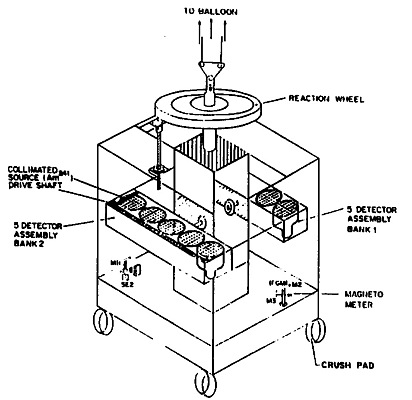Purpose of the flight and payload description
The TICAL MARK II X-Ray telescope was the second generation of a high sensitivity Nal/Csl phoswich X-ray telescope (area 1000 cm2) composed by two banks of five detectors each, collimated to a field of view of 5° x 5° FWHM. The telescope was built under a cooperation program between the Tata Institute of Fundamental research from India and the University of Calgary from Canada.
In the image at left we can see an scheme of the telescope (click to enlarge). Each detector consisted of a Nal(TI) scintillator (5mm) and a Csl (Na) scintillator (50 mm) of area 100 cm2 viewed by a single 127 mm diameter photomultiplier and equipped with a graded shield collimator.
Non-X-ray background photons were rejected by requiring that only signals characteristic of Nal (and not Csl) -as revealed by the pulse shape- were accepted. This "phoswich" technique reduced the background at ceiling altitude by a factor 10 to 20. The detectors have good efficiency in 20-150 keV range. The two banks of detectors were mounted, one on each side of central column, on a platform steerable in both the azimuth and the zenith to track the X-ray sources as they moved on the sky. An Am-241 radio-active source was used to periodically calibrate each detector. Signals from each detector, the telescope aspect and the house-keeping information were telemetered to ground. The arrival time of an X-ray photon were determined with great accuracy. This high time resolution was especially valuable in search for short (millisecond) periodicities in the X-ray sources.
Details of the balloon flight
Balloon launched on: 12/18/1988 at 5:15 IST
Launch site: TIFR National Balloon Facility, Hyderabad, India
Balloon launched by: National Balloon Facility, Tata Institute of Fundamental Research
Balloon manufacturer/size/composition: Zero Pressure Balloon Winzen Stratofilm (tow+main) 242.900 m3
Flight identification number: 398
End of flight (L for landing time, W for last contact, otherwise termination time): 12/18/1988
Balloon flight duration (F: time at float only, otherwise total flight time in d:days / h:hours or m:minutes - ): 10 h
Payload weight: 661 kgs
Overall weight: 1.155 kgs
The telescope weighting 476 kg. had its maiden flight on 18 December 1988 at 5:15 Indian Standard Time from Hyderabad on a 8.58 million cubic feet Winzen balloon. The payload floated at the ceiling altitude of 37.5 km for 10 hours.
Eight galactic X-ray sources were tracked for different time intervals according to an optimum "viewing schedule" fed into the memory of an on-board microprocessor. Because of the low signal-to-noise ratio of most X-ray sources, substantial time had to be devoted to the measurement of noise (background) in the different elevation and azimuth ranges traversed by the X-ray sources due to earth's rotation. Maximum exposure was obtained for Sco X-1 (115 min.). Cyg X-l, PSR 1907+9.7, GX1+4, GX5-1 and the radiopulsar 1951-32 were each scanned for 45-60 minutes. Her X-l and the radio pulsar PSR 1737+21 were tracked for 30 minutes each.
Preliminary analysis shows that the instrument performed according to the expectation. The detector count rates at the ceiling are about 40% less than those obtained with the Mark I telescope flown earlier. This, combined with the large area and reduced dead-time compared to the earlier telescope, will allow higher sensitivity for the X-ray observations.
A major objective in this flight was to confirm the earlier discovery of a transient millisecond pulsar (period 2.93 ms) during a 13 min. observation in December 1984 (IAUC 4485). The sensitivity of the present observation is several times better than the previous observation.
External references
- Balloon Flight Report 1969 -2003 TIFR website (via Archive.Org)
- Hard X-ray (20-120 keV) astronomy studies with a balloon-borne X-ray telescope using Nal/Csl phoswich detectors in Annual report 1988-89: Tata Institute of Fundamental Research, Pag. 31
- New balloon-borne telescope system TICAL-Mark II for hard X-ray astronomy Advances in Space Research, vol. 14, no. 2, p. (2)101
1042If you consider this website interesting or useful, you can help me to keep it up and running with a small donation to cover the operational costs. Just the equivalent of the price of a cup of coffee helps a lot.


